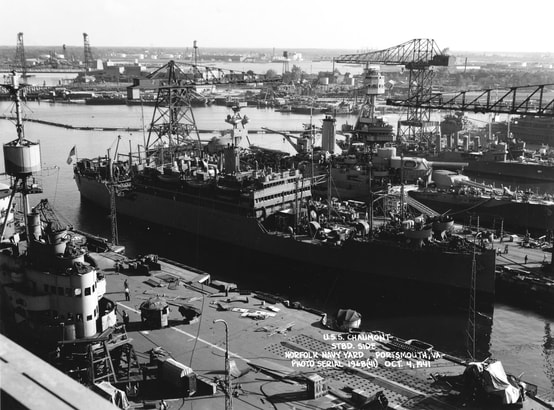
In the years just prior to World War I, the United States was establishing itself as a world power, Teddy Roosevelt had built the U.S. Navy into a strong fleet, and shipyards were busy. It was a time when blue-collar trade unions - some already three decades old - were beginning to negotiate better wages and working conditions, yet, in spite of the success of blue-collar workers in organizing and negotiating contracts during this period, white-collar workers were slow to assert themselves.
The first significant organization of engineers, and those in related occupations, was the national Society of Marine Draftsmen, established in 1913. At the first convention in 1914, many blind resolutions were uneventfully passed, but when the subject of wages was introduced, the chairman and resolutions committee arbitrarily rejected all proposals on the subject.
Upon investigation, the delegates found that the chairman and all Society officers occupied high management positions in large shipbuilding companies! The Society was, in fact, a company union. The Society broke up, but an energetic minority from Norfolk Naval Shipyard, Portsmouth, Virginia, seized the initiative to fill the void created when the Society self destructed. Assisted by American Federation of Labor (AFL) leaders, which prevented government intrusion, the Norfolk workers received a charter as a federal local union from the AFL and Draftsmen's Union No, 15327 was born.
The word went out to the shipyards. Workers in the appropriate jurisdiction were suffering from overwork and underpay. While organized mechanics were making excellent wages and premium overtime, "white-collar workers", including technical engineers and draftsmen, were receiving substandard wages, fancy titles pats on the back from the boss, and the opportunity to work plenty of overtime with no additional pay. White collar positions were paid less than blue collar and the normal required work day was from sunrise to sunset.
The first significant organization of engineers, and those in related occupations, was the national Society of Marine Draftsmen, established in 1913. At the first convention in 1914, many blind resolutions were uneventfully passed, but when the subject of wages was introduced, the chairman and resolutions committee arbitrarily rejected all proposals on the subject.
Upon investigation, the delegates found that the chairman and all Society officers occupied high management positions in large shipbuilding companies! The Society was, in fact, a company union. The Society broke up, but an energetic minority from Norfolk Naval Shipyard, Portsmouth, Virginia, seized the initiative to fill the void created when the Society self destructed. Assisted by American Federation of Labor (AFL) leaders, which prevented government intrusion, the Norfolk workers received a charter as a federal local union from the AFL and Draftsmen's Union No, 15327 was born.
The word went out to the shipyards. Workers in the appropriate jurisdiction were suffering from overwork and underpay. While organized mechanics were making excellent wages and premium overtime, "white-collar workers", including technical engineers and draftsmen, were receiving substandard wages, fancy titles pats on the back from the boss, and the opportunity to work plenty of overtime with no additional pay. White collar positions were paid less than blue collar and the normal required work day was from sunrise to sunset.
To correct these inequities, a national conference was convened on September 23, 1917, in New York City, Delegates came from Newport, Portsmouth, Boston, New York, Philadelphia, Charleston, and Norfolk.
The United States had declared war on Germany on April 6, almost six months before, U-boats were sinking allied shipping at an alarming rate. In reaction to this, draftsmen and others were being worked unmercifully, but not being paid for their work. When the new organization named a grievance committee to call on the shipyard operators, they were told, in effect, that it was the Navy department's headache; they should discuss their grievances with the government, since the yards were now operating under government control.
When the grievance committee arrived in Washington, DC, it was ushered into the office of a young Assistant Secretary of the Navy, Franklin D. Roosevelt. He listened to their complaints and to their delight, said that he agreed with them totally. An agreement was quickly reached which assured members of Draftsmen Union No, 15327 of time and a half for overtime in excess of eight hours a day.
The overwhelming success of this first meeting forcibly brought home to white-collar engineers and draftsmen the need for united action. Draftsmen in numerous private and government yards rushed to form local unions of their own, but there was still no national coordinating machinery. Six months before the armistice of World war I, a meeting was called in Washington, DC (May 19, 1918) to consider the formation of a national organization. The AFL granted a charter to the draftsmen on July 1, 1918, in the name of the International Federation of Draftsmen's Unions, Charter locals included: Local 1, Portsmouth, Virginia; Local 2, New York, New York; Local 3, Philadelphia, Pennsylvania; Local 4, Portsmouth, New Hampshire; Local 5, Newport, Rhode Island; Local 6, Charleston, South Carolina; Local 7, Quincy, Massachusetts; Local 8, Vallejo, California; and Local 12, Bremerton, Washington,
The first job for the newly-formed international union was to negotiate wage increases to meet the war-inflated cost of living, President Woodrow Wilson, impressed with this need, appointed the Macy Board to recommend wage rates in the ship-building industry, The International made a case for higher wages resulting in the establishment of rates in the private shipbuilding industry which almost doubled the former ones,
However, this did not affect draftsmen in naval shipyards, Another body, the Henry Board, was established to study that problem, Once again the International led the way, and liberal wage increases were granted federal draftsmen as well.
When the non-member draftsmen saw what had been achieved in two pivotal cases they applied for membership in droves, establishing the first significant membership gain for the new organization, In 1919, the fledgling union petitioned the ALF, to include other technical crafts. This was approved and the organization became known as the International Federation of Technical Engineers, Architects, and Draftsman's Union.
From its inception, this union of professional and technical engineering employees has enjoyed creative, industrious leadership from Local 1,
For nearly seven decades, Vice Presidents have been selected from our local, beginning with C,V, Schooler in 1916, who was the organizer and first president of Local 15327, and who received the charter signed by Samuel Gompers.
Through the years, other Norfolk employees, including Harvey Dale, Ralph Blackmun, and Albert Resolute, (currently a member of the international staff), have provided the continuity and guidance vital for the success of the union, For over 75 years the International Federation of Professional and technical Engineers (the union changed its' name to more accurately reflect its jurisdiction over the years), has achieved success in its' primary mission of improving the wages, hours, and working conditions of its membership, It will continue to be the employees' guidance of economic justice and dignity in the workplace by defending its members at the bargaining table and in the halls of Congress,
Perhaps the greatest achievement of all for IFPTE has been its success in proving, in the hearts and minds of white-collar membership, that a union is not demanding but is uplifting, the individuals do not surrender their rights, they multiply and solidify them, Membership in a trade union does not obliterate, nor conflict with loyalty to an employer, It makes it more meaningful and permanent.
The United States had declared war on Germany on April 6, almost six months before, U-boats were sinking allied shipping at an alarming rate. In reaction to this, draftsmen and others were being worked unmercifully, but not being paid for their work. When the new organization named a grievance committee to call on the shipyard operators, they were told, in effect, that it was the Navy department's headache; they should discuss their grievances with the government, since the yards were now operating under government control.
When the grievance committee arrived in Washington, DC, it was ushered into the office of a young Assistant Secretary of the Navy, Franklin D. Roosevelt. He listened to their complaints and to their delight, said that he agreed with them totally. An agreement was quickly reached which assured members of Draftsmen Union No, 15327 of time and a half for overtime in excess of eight hours a day.
The overwhelming success of this first meeting forcibly brought home to white-collar engineers and draftsmen the need for united action. Draftsmen in numerous private and government yards rushed to form local unions of their own, but there was still no national coordinating machinery. Six months before the armistice of World war I, a meeting was called in Washington, DC (May 19, 1918) to consider the formation of a national organization. The AFL granted a charter to the draftsmen on July 1, 1918, in the name of the International Federation of Draftsmen's Unions, Charter locals included: Local 1, Portsmouth, Virginia; Local 2, New York, New York; Local 3, Philadelphia, Pennsylvania; Local 4, Portsmouth, New Hampshire; Local 5, Newport, Rhode Island; Local 6, Charleston, South Carolina; Local 7, Quincy, Massachusetts; Local 8, Vallejo, California; and Local 12, Bremerton, Washington,
The first job for the newly-formed international union was to negotiate wage increases to meet the war-inflated cost of living, President Woodrow Wilson, impressed with this need, appointed the Macy Board to recommend wage rates in the ship-building industry, The International made a case for higher wages resulting in the establishment of rates in the private shipbuilding industry which almost doubled the former ones,
However, this did not affect draftsmen in naval shipyards, Another body, the Henry Board, was established to study that problem, Once again the International led the way, and liberal wage increases were granted federal draftsmen as well.
When the non-member draftsmen saw what had been achieved in two pivotal cases they applied for membership in droves, establishing the first significant membership gain for the new organization, In 1919, the fledgling union petitioned the ALF, to include other technical crafts. This was approved and the organization became known as the International Federation of Technical Engineers, Architects, and Draftsman's Union.
From its inception, this union of professional and technical engineering employees has enjoyed creative, industrious leadership from Local 1,
For nearly seven decades, Vice Presidents have been selected from our local, beginning with C,V, Schooler in 1916, who was the organizer and first president of Local 15327, and who received the charter signed by Samuel Gompers.
Through the years, other Norfolk employees, including Harvey Dale, Ralph Blackmun, and Albert Resolute, (currently a member of the international staff), have provided the continuity and guidance vital for the success of the union, For over 75 years the International Federation of Professional and technical Engineers (the union changed its' name to more accurately reflect its jurisdiction over the years), has achieved success in its' primary mission of improving the wages, hours, and working conditions of its membership, It will continue to be the employees' guidance of economic justice and dignity in the workplace by defending its members at the bargaining table and in the halls of Congress,
Perhaps the greatest achievement of all for IFPTE has been its success in proving, in the hearts and minds of white-collar membership, that a union is not demanding but is uplifting, the individuals do not surrender their rights, they multiply and solidify them, Membership in a trade union does not obliterate, nor conflict with loyalty to an employer, It makes it more meaningful and permanent.

